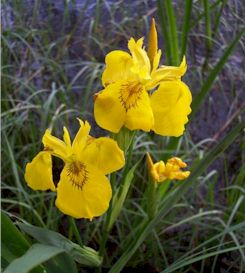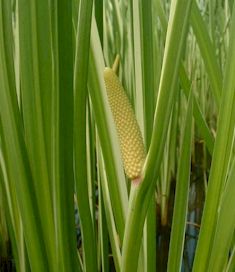|

Flag |
Our English water Flags are true whigs of the old school, and get their generic name because hanging out their banners respectively of dark blue and yellow.
Each is also called Iris, as resembling the rainbow in beauty of color. The land Flag (Iris versicolor) is well known as growing in swamps and moist meadows, with sword-shaped leaves, and large purple heads of flowers, bearing petals chiefly dark blue, and veined with green, yellow, or white. The water Flag (Iris pseudacorus) is similar of growth, and equally well known by its brilliant heads of yellow flowers, with blade-like leaves, being |
found in wet places and water courses. The root of the Blue Flag, "Dragon Flower," or "Dagger Flower," contains chemically an "oleo-resin," which is purgative to the liver in material doses, and specially alleviative against bilious sickness when taken of much reduced strength by reason of its acting as a similar. The official dose of this "iridin" is from one to three grains. A liability to the formation of gall stones may be remedied by giving one grain of the oleoresin (iridin)
every night for twelve nights.
A medicinal tincture (H.) is made which holds this Iris in solution; and if three or four drops are taken immediately, with a spoonful of water, and the same dose is repeated in half-an-hour if still necessary, an attack of bilious vomiting, with sick headache, and a film before the eyes, will be prevented, or cut short. The remedy is, under such circumstances, a trustworthy substitute for calomel, or blue pill. Orris powder, which is so popular in the nursery, and for the
toilet table with ladies, on account of its fresh "violet" scent, is made from the root of this Iris, being named from the genitive ireos.
Louis VII. of France chose this Blue Flag as his heraldic emblem, and hence its name, fleur de lys, has been subsequently borne on the arms of France. The flower was said to have been figured on a shield sent down from heaven to King Louis at Clovis, when fighting against the Saracens. Fleur de Louis has become corrupted to fleur de lys, or fleur de lis.
The Purple Flag was formerly dedicated to the Virgin Mary. A certain knight more devout than learned could never remember more than two words of the Latin prayer addressed to the Holy Mother; these were "Ave Maria", which the good old man repeated day and night until he died. Then a plant of the blue Iris sprang up over his grave, displaying on every flower in golden letters these words, "Ave Maria". When the monks opened the tomb they found the root of the plant resting on
the lips of the holy knight whose body lay buried below.
|

Yellow Flag |
The Yellow Flag, or Water Flag, is called in the north, "Seggs." Its flowers afford a beautiful yellow dye; and, its seeds, when roasted, can be used instead of coffee. The juice of the root is very acrid when sniffed up the nostrils, and causes a copious flow of water there from, thus giving marked relief for obstinate congestive headache of a dull, passive sort. The root is very astringent, and will
check diarrhea by its infusion; also it is of service for making ink. In the south of England the plant is named "Levers." It contains much tannin.
|
The "Stinking Flag," or "Gladdon," or "Roast Beef," because having the odor of this viand, is another British species of Flag, abundant in southern England, where it grows in woods and, shady places. Its leaves, when bruised, emit a strong smell like that of carrion, which is very loathsome. The plant bears the appellations, Iris foetidissima, Spatual foetida, and "Spurgewort," having long, narrow leaves, which stink when rubbed. Country folk in Somersetshire
purge themselves to good purpose with a decoction made from the root. The term "glad," or "smooth," refers to the surface of the leaves, or to their sword-like shape, from gladiolus (a small sword), and the plant bears flowers of a dull, livid purple, smaller than those of the other flags.
|

Sweet Flag |
Lastly, there is the Sweet Flag (Acorus calamus), though this is not an Iris, but belongs botanically to the family of Arums. It grows on the edges of lakes and streams allover Europe, as a highly aromatic, reedy plant, with an erect flowering stem of yellowish green color. Its name comes from the Greek, koree, or "pupil of the eye," because of its being used in ailments of that organ. |
"Calamus" was the Roman term for a reed; and formerly this sweet Flag, by reason of its pleasant odor like that of violets, was freely strewn on the floor of a cathedral at times of church festivals, and in many private houses instead of rushes. The root is a powerful cordial against flatulence, and passive indigestion, with headache. It contains a volatile oil, and a bitter principle, "acorin;" so that a fluid extract is made by the chemists, of which from thirty to forty
drops may be given as a dose, with a tablespoonful, of water, every half-hour for several consecutive times. The candied root is much employed for like uses in Turkey and India. It is sold as a favorite medicine in every Indian Bazaar; and Ainslie says it is reckoned so valuable in the bowel complaints of children, that there is a penalty incurred by every druggist who will not open his door in the middle of the night to sell it if demanded.
The root stocks are brought to this country from Germany, being used by mastication to cleat the urine when it is thick and loaded with dyspeptic products; also for flavoring beer, and scenting snuff.
Their ash contains potash, soda, zinc, phosphoric Acid, silica, and peroxide of iron. In the "Times" April 24th, 1856, Dr. Graves wrote commending for the soldiers when landing at Galipoli, and notable to obtain costly quinine, the Sweet Flag--acorus calamas--as their sheet anchor against ague and allied maladies arising from marsh miasmata. The infusion of the root should be given, or the powdered root in doses of from ten to sixty grains. (See RUSHES.)
Herb Simples
The Primitive Simplers presented here show the way of life in other generations, it is not suggested or recommended trying them yourself. |
|
Garden
Herbs
Home
History of Herbs
Herb Gardening
Herbs for Beginners
Drying & Preserving Herbs
Indoor Herb Gardening
Herb Garden
Hints & Tips
Herbal
Cooking
Herb Chart
Using Herbs
Culinary Herbs
Herb
Oil and Vinegar
Herb Teas
Herb Candy
Herb Jelly
Herb Simples
Preface
Introduction
Alphabetical Listing

Trade
Recipes Online
Share your Recipes with others!!
|




